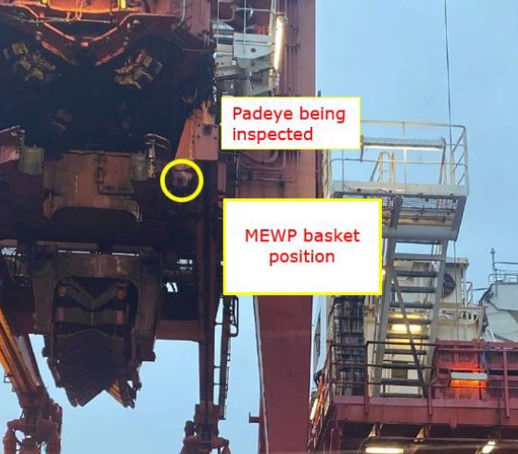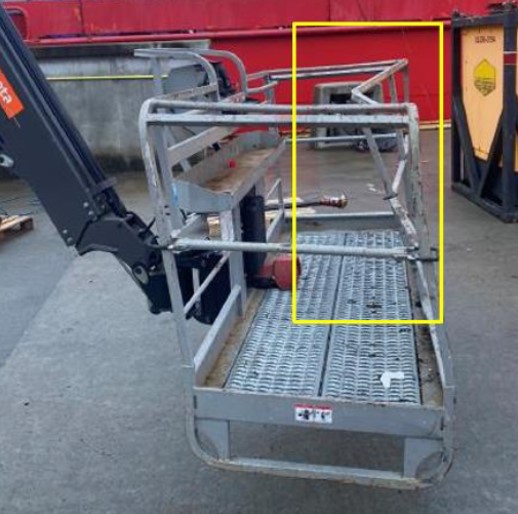- IP Code: Mandatory Code enters into force on 1 July. Make sure your company is up to speed with the changes.
- Early Bird tickets available for the IMCA Global Summit 2024. 3-4 December, Utrecht, Netherlands. Members can save £400.
- Discover how we are helping Members reduce emissions: Explore the ProjectGHG hub now.
- Now booking. Join the Lifting and Rigging community at our Technical Seminar in Amsterdam. Thursday 12 September 2024
- Now booking. Underwater Ship Husbandry Seminar. 10 October 2024, Singapore.
Equipment on quay damaged when vessel started listing
What happened
During inspection of two pad eyes on a Tiltable Lay System (TLS) using a “cherry picker” or mobile elevated work platform on the quayside, the vessel slowly listed, causing the pipelay tower to come into contact with the work basket on the cherry picker. The hand rail on the work basket was damaged.
It is not thought that the “cherry picker” could have toppled over, due to the minimal reach of the basket and the fact that the load caused by the vessel was being absorbed by the deformation of the hand rail on the basket.


What went wrong?
Investigation determined:
- There was no Permit to Work (PTW) for the task – no control of work on the quayside or assessment of vessel Simultaneous Operations (SIMOPs);
- The Task Risk Assessment (TRA) did not include:
- SIMOPS hazards of potential listing of vessel due to crane movements or wash from other vessels;
- hazard of the “cherry picker” work basket being close to the vessel structure and clashing with it;
- The different toolbox talks takin place did not discuss the other simultaneous tasks occurring;
- The person operating the “cherry picker” had no valid training for it.
What went right?
The platform on the pipelay tower was accessible from the work basket. Crew in the work basket made the decision to exit the basket onto the tower and did so in a safe and controlled manner, unclipping from the basket and clipping onto the pipelay platform before climbing across.
What was the cause?
Uncontrolled simultaneous operations: during the pad eye inspection the vessel was observed to slowly list towards the quayside due to a vessel crane movement;
Actions
- Ensure Permit to Work is required for non-routine hazardous Working at Height tasks i.e. for tasks where routine established procedures are not in place and in use. Worksite management should be responsible for determining on a case by case basis when a Permit to Work is required for working at height tasks.
- Review and update Task Risk Assessments to include potential for vessel movement and communication of SIMOPS activities;
- Ensure that all work that can be impacted by deck activities, is highlighted and discussed at cross-departmental TBTs;
- Have an effectively practiced and drilled plan for emergency rescue when anyone is working at height;
- If unsure of the correct method to execute a task, or the associated risks, STOP the JOB and ASK!
Members may wish to refer to:
- IMCA M 203 Guidance on simultaneous operations (SIMOPS)
- LTI: Stored energy – rigger injured leg working on quayside [causal factor: There were simultaneous activities occurring in the area which were not properly controlled]
- SIMOPS – Smoke from hot work task enters confined space [improvement identified: “Additional focus to be placed on SIMOPS during the daily planning meeting”]
- Crane contact with pipelay tower resulting in dropped object
Safety Event
Published: 10 February 2022
Download: IMCA SF 04/22
IMCA Safety Flashes
Submit a Report
IMCA Safety Flashes summarise key safety matters and incidents, allowing lessons to be more easily learnt for the benefit of all. The effectiveness of the IMCA Safety Flash system depends on Members sharing information and so avoiding repeat incidents. Please consider adding [email protected] to your internal distribution list for safety alerts or manually submitting information on incidents you consider may be relevant. All information is anonymised or sanitised, as appropriate.
IMCA’s store terms and conditions (https://www.imca-int.com/legal-notices/terms/) apply to all downloads from IMCA’s website, including this document.
IMCA makes every effort to ensure the accuracy and reliability of the data contained in the documents it publishes, but IMCA shall not be liable for any guidance and/or recommendation and/or statement herein contained. The information contained in this document does not fulfil or replace any individual’s or Member's legal, regulatory or other duties or obligations in respect of their operations. Individuals and Members remain solely responsible for the safe, lawful and proper conduct of their operations.
